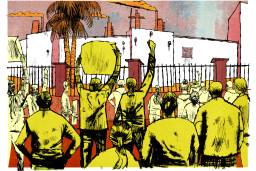How to Save Retirement (It’s Simple, and It’s Not Chained CPI)
President Obama is wrong: Social Security is not the problem--it’s the solution.
Steven Hill

Recently, President Barack Obama proposed the unthinkable for a Democratic president: a cut in Social Security through “chained CPI.” Not only has he proposed cuts, but his cuts are greater than those proposed by Rep. Paul Ryan and the GOP. Yet the knee-jerk Republicans rejected Obama’s plan anyway because, well, that’s just what Republicans do.
Unfortunately, the two sides in this so-called debate are “cut” and “cut more,” with a disorganized gaggle of progressive Democrats trying desperately to preserve the status quo. Yet none of these positions are rooted in the reality of the collapsing U.S. retirement system. Obama’s approach toward Social Security not only is wrong in its diagnosis and prescriptions, but it will be disastrous in its consequences.
The real monster under the bed is not the long-term solvency of Social Security, as the deficit busters in both parties would have us believe. Rather it is the fact that, due to the failure of the current retirement system, millions of Americans are facing an insecure and underfunded retirement. A more realistic assessment reveals that the solution to America’s retirement crisis lies in the opposite direction — expanding Social Security, not cutting it. In a new policy paper entitled “Expanded Social Security” (which I co-authored), the New America Foundation shows how to create a more robust retirement system in an affordable way that actually could decrease the total amount of national wealth being expended on today’s unstable system.
Collapse of the “three-legged stool” of retirement security
Here’s the dilemma that the U.S. faces. Since World War II, retirement has been conceived as a “three-legged stool,” with the three legs being Social Security, employer retirement plans and private assets (centered around homeownership). But the first leg, the one based on employer-based retirement plans, has been hacked back to a nub.
Occupational pensions with a guaranteed payout have declined to near obsolescence since the mid-1980s. Today, less than 15 percent of all private sector workers and 32 percent of those in large companies have these pensions, a decline of 62 percent from the peak.
Unfortunately, the replacements for pensions — 401(k)s, IRAs and other tax-favored private savings vehicles — have proven disastrous. These were sold to American workers as the new and improved versions of traditional pensions, but in the recent financial crash, individuals lost a total of $2.8 trillion in value of their 401(k)s or IRAs.
Without sufficient additional liquid savings, many workers have been forced to draw from their 401(k)s to pay for contingencies during their working years. Nearly 40 percent of employee contributions to 401(k)s were withdrawn in 2010, a move that carries with it significant penalties for individuals.
Even before the crash, the dirty little secret was that these savings vehicles chiefly benefited the affluent, who could afford to accumulate large amounts of savings in the tax-deferred accounts. Of the $165 billion the government will spend this year to subsidize individual retirement savings through programs such as 401(k)s, nearly 80 percent will accrue to the top 20 percent of earners.
Despite this inherent instability and unfairness, 401(k)s have grown from covering only 17 percent of the private workforce to 42 percent today. But as the recent economic collapse illustrated dramatically, these tax-incentivized savings vehicles have only succeeded in shifting risks onto individuals, who are even more vulnerable than businesses.
Second Failing Leg of Retirement Security: Homeownership
The second failing leg of the U.S. retirement system consists of individual asset ownership, primarily based on the value of people’s homes. For millions of Americans, the rupture of the housing bubble resulted in homeowners losing approximately $8 trillion in value, a 53 percent drop in the value of the nation’s homeownership stock. About 10.7 million Americans — nearly a quarter of all homeowners — are still underwater, owing more on their mortgage than their home is worth.
These homeowners are, in effect, flat broke if they have no other accumulated savings or retirement vehicle (and most don’t). This has been devastating for Americans’ retirement well-being because home ownership accounts for a large proportion of the assets owned by much of the population. And with home prices recovering at a glacial pace in most parts of the country, this loss in equity has significantly reduced the economic security of the lower and middle classes, which are less likely to have pensions and other assets such as private savings (beyond homeownership) to sustain them. This enormous asset loss has illustrated dramatically the danger of over-reliance on home values for retirement security.
When combined with increased inequality even before the Great Recession, this has drastically reduced Americans’ personal savings. In short, two of the three legs of America’s retirement system have been sawed off, and half of all Americans are at risk of not having sufficient retirement income. Three-fifths of low-income households are at risk of not having sufficient retirement income to maintain their pre-retirement standards of living after age 64 (which were low standards to begin with).
The U.S. retirement system has become an unstable one-legged stool. Suddenly Social Security, which always has been viewed as a supplement to private savings, is the only leg left for tens of millions of American retirees.
That’s what makes the current debate over Social Security, and Obama’s proposed cuts, so puzzling. While Social Security is facing a funding shortfall two decades away, nevertheless it has proven to be far more stable and successful than the other two legs of the stool. Yet many critics of Social Security not only are proposing cuts, but also an expansion of the failed 401(k)s and IRAs in order to compensate for the allegedly necessary cuts in Social Security.
Most people don’t realize how crucial Social Security already has become for most retirees. The bottom forty percent of elderly earners get about 84 percent of their retirement income from Social Security, and individuals in the middle-income quintile (40th to 60th percentile) rely on Social Security for nearly two-thirds of their income. With the collapse of the other two legs, those percentages likely will rise. Like it or not, Social Security has become America’s de facto national retirement system, a role for which the current program was not designed.
Indeed, the problem with Social Security is not that is underfunded — it’s that it doesn’t pay out enough in benefits. Currently, Social Security replaces around 33 to 40 percent of an average worker’s annual income during retirement. Yet most experts say that retirees will need at least 70 percent of their earnings to be able to maintain their standard of living. That is simply not enough money to live on when it is your primary, or perhaps your only, retirement income. Many other developed nations are far less stingy, having an “earnings replacement rate” of around 60 percent.
Expanded Social Security: A Proposal for a New Retirement Security System
In reforming America’s retirement security system, we should build upon what works, not what has failed. Instead of compounding failure by expanding private benefit plans that are subject to the whims of the stock market and mostly have benefited the affluent, we should substantially expand the successful and popular Social Security program.
The New America Foundation plan, called “Expanded Social Security,” proposes a two-part, or “double-decker” plan (much like Medicare is divided into parts A, B, C and D). The current Social Security program (to be renamed Social Security A) would remain an earnings-based, defined benefit plan, where workers would accrue benefits based on lifetime earnings. In addition, this plan would be supplemented by a second part, Social Security B, which would be a universal flat benefit for all retired Americans. Combined, Social Security A and B would be set at a level to meet the goal of replacing 60 percent of income for a middle-income earner.
This does not have to be an expensive proposition. Currently, the overall retirement system, including not only Social Security but also private components such as disbursals from tax-favored employer and individual retirement plans, consumes about 13 percent of the nation’s gross domestic product. But this expanded Social Security system, combined with a smaller private savings component, would use up an estimated 12.4 percent of GDP. That might sound like a small difference, but in a $14 trillion economy, it amounts to about $80 billion in potential annual savings.
The funding for Social Security A — as well as the best way to close the expected shortfall in funding for promised benefits that is predicted to occur in the 2030s — would not come from Obama and the GOP’s benefit cuts but instead from revenue increases. The best way to achieve this is by increasing or lifting entirely the current unfair payroll cap that funds Social Security. That payroll cap means that each American pays a tax only on the first $113,700 of their income. If you earn above that amount, you don’t pay any more tax on income greater than that amount. This is a regressive structure, and means that millionaire bankers pay a far lower percentage of their income toward Social Security than does an average wage earner.
Social Security B would be funded by revenues other than the payroll tax, such as by reducing or eliminating the substantial tax deductions that chiefly benefit the affluent. For example, the US government spends about $100 billion per year on the home mortgage deduction, yet income filers making over $100,000 dollars per year received nearly 75 percent of this benefit in total dollars in 2011. And businesses receive substantial federal deductions in the amount of $126 billion annually in return for providing their employees with retirement plans.
But this expansion of Social Security would make both tax-favored employer-based pensions and tax-favored individual savings vehicles less necessary, allowing federal tax expenditures for those private programs to be reduced or eliminated. In effect, we would be using Social Security to replace the enormous amounts of money wasted on private retirement supports that have failed to do their job.
We also should devote more from general revenues or a new value-added tax as a way to pay for Social Security B. Because most general taxation comes from more affluent individuals, using more of these revenues to pay for an expansion of Social Security will supplement retirement income for all individuals from taxation that more heavily draws from high-income earners.
So this double-decker public system, which is like ones used in Canada and Japan, would result in spending less of our nation’s wealth on retirement than the current public-private mix. And it will make the system as a whole much more fair and stable.
In addition to increasing the retirement security of most Americans, Expanded Social Security would result in other benefits for the broader macroeconomy. It would make each individual’s retirement plan portable from job to job, so that she or he would be able to pay into their retirement no matter where they work. It also would act as an “automatic stabilizer” during economic downturns, keeping money in retirees’ pockets and stimulating consumer demand, especially among low- and middle- income individuals who are more likely to spend an extra dollar on goods and services than are affluent individuals.
And Expanded Social Security would help American businesses trying to compete with foreign companies that don’t have to provide pensions to their employees, because those countries already have national retirement plans.
In reforming America’s retirement security system, we should build upon what has worked. Expanding the ever-popular Social Security would provide a more stable and secure retirement for every American and contribute greatly toward a solid foundation from which to build a strong and vibrant 21st-century economy. America’s hard-working citizens deserve no less.

I hope you found this article important. Before you leave, I want to ask you to consider supporting our work with a donation. In These Times needs readers like you to help sustain our mission. We don’t depend on—or want—corporate advertising or deep-pocketed billionaires to fund our journalism. We’re supported by you, the reader, so we can focus on covering the issues that matter most to the progressive movement without fear or compromise.
Our work isn’t hidden behind a paywall because of people like you who support our journalism. We want to keep it that way. If you value the work we do and the movements we cover, please consider donating to In These Times.
Steven Hill is co-founder of FairVote and the author of seven books, including“10 Steps to Repair American Democracy” and “Fixing Elections: The Failure of America’s Winner Take All Politics”. His opinions are his own.






